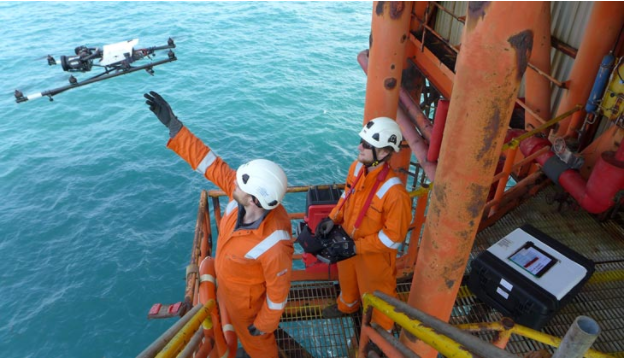The current methods of locating, detecting and surveying leaks in rugged, remote offshore oil and gas locations can be cost-prohibitive and inefficient because of shutdowns and with safety being the utmost priority for offshore ventures, the employees have to work in conditions that are not ideal during the inspection process.
The major concerns associated with running a successful offshore operation are cost and safety. With the introduction of aerial drones in this area, the modern technology has provided a solution to these concerns.
>See also: Autonomous drones in the oil and gas industry
The drones or UAVs (unmanned aerial vehicles) are simply stated as any aircraft without the physical presence of a human pilot in them. They may be operated by humans remotely or they may be autonomous with the preset logistics dictating speed, task, path and more controlled by a GPS program and sophisticated software.
Utilizing drones for offshore oil and gas operations can reduce costs due to their efficiency, mobility and speed. The safety can also be improved by eliminating the need for humans to carry out few tasks.
How can drones enable offshore operations?
Drones can be utilised in offshore oil and gas industry for applications such as monitoring of gas emissions, security, detection of oil spill and damages, the inspection of offshore oil platform and flare stack inspections.
When fast flight control responsiveness is vital, the drones can enable detailed optical imagery in case of flare stack head inspections. Here, the risk can be reduced to a greater extent as the employees do not need to climb the stacks and there is no need for shutting down the stacks for ensuring safety of employees thus eliminating the interruption of production which adds up to as much as US $4 million as stated by SkyFutures, a drone inspection organisation that specialises in oil and gas industry. The aerial inspection also enables early detection of any damage to structural abnormalities, piping and other external and internal inconsistencies, enabling proactive maintenance.
>See also: The autonomous miniature military drone
In case of the inspections of offshore oil platform, the drones can fly within a few feet of offshore platform and simultaneously sends real-time data to operator on the work boat or rig including HD video as well as still imagery from all angles.
This provides critical information to the operators and with this information, they can analyse the platform and plan any required work in advance with a 360 degree 3D Mapping for a fully fleshed out picture. This again eliminates the need for physical presence of employees on the rigs for inspection purpose.
To eliminate the danger of an oil spill, certain precautionary measures must be taken to prevent contamination or rapidly detect and arbitrate in the event of an oil spill. The sensors can be attached to drones and they can quantify and measure the oil spills to analyse how fast and where the oil is spreading. If this information comes in real time, the response vessels will exactly know the place they must go and decreases dispersal and recovery time.
In the offshore, the gas emissions are extremely difficult to monitor. The optical sensors present on few drones can manageably identify and survey leaks, decreasing the inspection costs and making them much safer for employees.
Few offshore vessels are positioned in locations where piracy is a major concern and drones can keep the assets and infrastructure more secure by providing eyes in the sky and thus offering operators a 360 degrees aerial view of surrounding area.
>See also: Are drones set to become the biggest threat to national security?
The future
The usage of drones offer a high potential for the offshore oil and gas industry to become more intelligent, more productive and more safer but there are obstacles to overcome due to current network and regulatory limitations.
The industry is continuing to modernise its approaches like employing remote medics for rigs who can communicate with physicians through teleconferencing for on-the-spot medical diagnosis and treatment on the rig. The organisations may soon find that it is hard to live without drones. With the accurate network, the oil and gas industry can reach new levels of safety and efficiency with the help of drones.
Sourced by Savaram Ravindra, Content Contributor at Tekslate.com
The UK’s largest conference for tech leadership, TechLeaders Summit, returns on 14 September with 40+ top execs signed up to speak about the challenges and opportunities surrounding the most disruptive innovations facing the enterprise today. Secure your place at this prestigious summit by registering here







